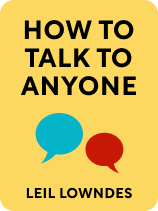

This article is an excerpt from the Shortform book guide to "How to Talk to Anyone" by Leil Lowndes. Shortform has the world's best summaries and analyses of books you should be reading.
Like this article? Sign up for a free trial here .
Do you find it easy to connect with new people? How do you move beyond superficial conversations and get a person to talk with you on a deeper level?
The key to connecting with anyone on a deep level is to show the person that you are like them. People interpret their similarities as a form of agreement that convinces them that their approach to life is correct—this increases their self-confidence and makes it easier for them to relax in your presence.
Here’s how to connect with people on a deeper level, according to communications expert Leil Lowndes.
Foster Empathy Using Mirroring
In How to Talk to Anyone, Leil Lowndes explains how to connect with people on a deeper, more personal level. The key, according to Lowndes, is to emphasize your similarities: People feel more comfortable revealing the truth about themselves to those who seem to be just like them—those who share similar traits, interests, and values.
(Shortform note: Psychologists add insight into why we like people who are just like us: Similarity validates your choices. Meeting people who think about life in the same way that you do decreases your uncertainty about whether or not you’re making the right choices.)
She suggests that you can encourage people to believe that you’re just like them by adopting the following four tactics.
Tactic #1: Match Their Mood
Show that you empathize with their emotions by tuning into their mood and matching their tone and pace. This will make them feel like you’re on the same wavelength as them. For example, if they talk quickly because they’re excited about something, try to maintain that high when you speak.
(Shortform note: One way to match your partner’s mood is to speak about emotionally similar experiences. This deepens your emotional connection because it demonstrates two things: First, you’re actively listening to them and you understand their emotions. Second, you accept how they feel and you’re willing to join them where they are.)
Tactic #2: Repeat Their Words Back to Them
Listen to the specific words they use and echo them back when it’s your turn to speak. Finding ways to incorporate their vocabulary into what you say will make them believe you share their values and think like them.
(Shortform note: In addition to simulating a feeling of similarity, paraphrasing your conversation partner’s words also ensures that you understand what’s being said in the spirit in which it’s intended. Repetition helps you to clarify what the speaker’s saying. This gives them the comfort of knowing that they’re understood and makes them more inclined to form an emotional connection to you.)
Tactic #3: Make Supportive Statements
Show that you understand what they’re feeling by using short empathetic statements that match the senses they use to express them. For example, if they talk about how they saw something, you could say, “I see what you mean.” If they talk about how they felt about something, you could say, “I understand how you feel.” These short sentences will make them believe that you interpret the world in the same way that they do and will encourage them to continue. Additionally, this tactic helps to keep the conversation flowing if you find yourself at a loss for words.
(Shortform note: Neuro-linguistic research confirms that sense-matching does subconsciously increase rapport between people. However, trying to mirror another person’s sensory language before you feel any emotional connection to them can backfire—others are likely to consciously notice your attempts and feel like you’re trying to manipulate them. Therefore, wait until you begin to feel a genuine emotional connection to what’s being said before attempting this tactic—this way, you won’t inadvertently repel the people you’re trying to connect with.)
Tactic #4: Use “We,” “Us,” and “Our” to Imply Friendship
Create a feeling of connection and intimacy by using language that presupposes that you’re already friends. When people are in a close relationship, they automatically refer to themselves with words that unite them, such as “we” and “us.” Using these words tricks others into believing that you’re already friends. For example, instead of saying, “I’m going to find some food,” say, “Shall we find some food?”
(Shortform note: While there’s nothing to prove that using the word “we” will trick someone into being your friend, there is proof that it will make you feel happier. Psychological studies show that the pronouns you use most often directly impact your emotional state: Relationship pairs that use “we” and “us” tend to feel happier and calmer and they find it easier to express positive emotions such as respect or affection. On the other hand, relationship pairs that use “I” or “you” tend to be less happy—they have negative facial expressions, negative tones of voice, and project an air of rejection or disdain.)

———End of Preview———
Like what you just read? Read the rest of the world's best book summary and analysis of Leil Lowndes's "How to Talk to Anyone" at Shortform .
Here's what you'll find in our full How to Talk to Anyone summary :
- Practical techniques to help you overcome social discomfort
- How to confidently develop new connections
- How to appear more likable without saying a word






